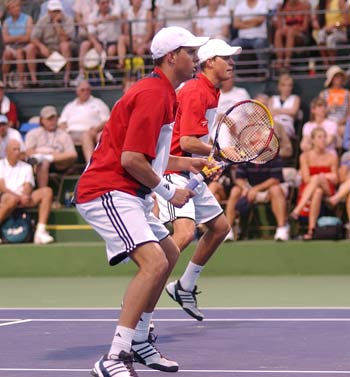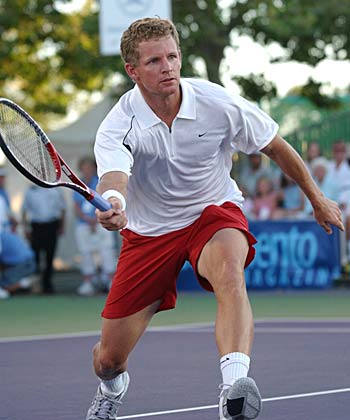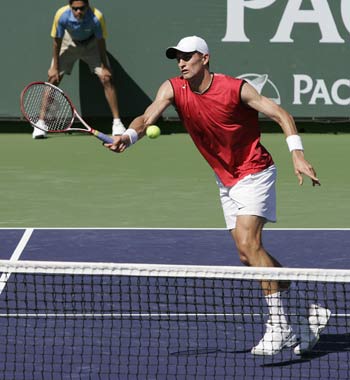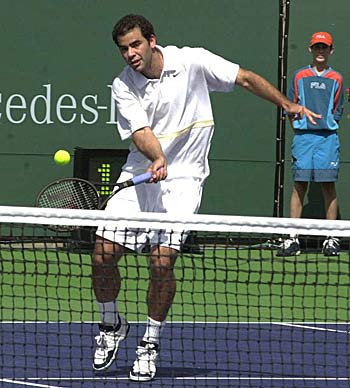
What's Wrong With The ATP's Doubles Reforms?
Paul Fein
“O! many a shaft, at random sent, Finds mark the archer little meant!”
— Sir Walter Scott
After three decades of policy blunders, the ATP may have delivered the coup de grace to the great event of doubles. To try to entice leading singles players to enter doubles events, ATP tournaments will use No-Ad scoring and sets played to five games (instead of six) with a tiebreaker when games reach 4-4. This scoring system is not even approved by the International Tennis Federation, which governs the rules of tennis. These and other highly important rule changes—announced during Wimbledon and going into effect after the U.S. Open—were made without consulting the ITF and only a few present and past singles and doubles standouts whose expertise, experience and ethics the ATP sorely needs.
Let's examine the radical ATP rule changes from various angles.
A Difference of Opinion
A June 30 press release titled “ATP to Implement Doubles Enhancements” states that a Research & Development Doubles Project Team—which was chaired by Horst Klosterkemper, ATP President Europe and Player Relations, and included player representatives, tournament directors and ATP staff—“evaluated data from surveys from four target groups: fans, players, media and tournaments. One hundred players equally represented from Top 100 in doubles and singles were interviewed, and 4,837 fans responded to an ATPtennis.com survey.” That the ATP does not reveal this “data” suggests that the data may not have supported its position. What other reason is there for being secretive?
 "All of the players Bob and I have talked to think they are going to be bad for doubles and fans. People are going to lose a lot of respect for doubles." |
The leading doubles players and teams have the greatest stake in the planned doubles reforms, and several immediately denounced them. “We hate these rule changes,” says Mike Bryan, who with his twin brother Bob won the 2003 French Open and reached the Australian, French and Wimbledon finals this year. “All of the players Bob and I have talked to think they are going to be bad for doubles and fans. People are going to lose a lot of respect for doubles. There's not a lot we can do with this system, because the players voted against it, and the tournaments passed it, so it's a pretty corrupt system.”
Money is the root of the ineptitude, according to Bob Bryan. “Doubles players have almost no voice in the ATP. Decisions are made by penny-pinching businessmen who are frustrated to pay an extra five bucks to accommodate their product. Even though doubles prize money was cut 30 percent a couple years ago—the cuts were put right into the singles prize money—tournament directors still constantly complain about the money they pay for extra hotel rooms and food tickets for doubles players. Most directors don't respect doubles and appreciate its value to the sport and their tournaments.
“They should promote doubles and doubles players rather than damage the sport with absurd rule changes,” concludes Bryan . “Five-game sets with No-Ad scoring will bring an exhibition atmosphere to a professional sport we all have sweated blood working at our whole lives. Like most of the other players on the tour, we feel cheated by the ATP.”
All-time doubles great Todd Woodbridge, who owns 22 Grand Slam doubles titles and served as president of the ATP Player Council in 2001-02, denies he and other cognoscenti were even consulted. “The entire ATP board should resign, because they have made changes without asking what the rest of the tennis world thinks,” says Woodbridge. “Their decisions during the past two-and-a-half years helped improve the positions of their own tournaments—Indian Wells (Charlie Pasarell) and Metz (Patrice Dominguez) are the biggest beneficiaries—but were clearly not in the best interest of other tournaments on the calendar. The player representatives on the Board—Bob Brett, Tomas Carbonell and Ricardo Acioly—have defied the clear wishes of the Player Council by passing this latest doubles directive.”
Mark Woodforde, who captured 17 Grand Slam doubles crowns, including 11 with Woodbridge, is “shocked to the core” about the coming doubles changes. “Anyone who believes that shortening sets, No-Ad scoring, etc., will enhance the game of doubles is a bloody idiot,” blasts Woodforde. “And there's no way these changes will allow more doubles matches to be played on center court early in the week.”
Swedish veteran Jonas Bjorkman, ranked No. 1 in doubles, also fingered the ATP as the problem and not the solution. “They're doing a lousy job of promoting doubles. That's the problem,” Bjorkman told the Ft. Lauderdale Sun-Sentinel .
What Do Singles Stars Really Want?
The ATP's main rationale for its rule changes is to induce leading singles players to enter doubles events more often. But that won't happen, according to Mark Knowles, former world No. 1 in doubles and current vice president of the ATP Players Council. “I've done a lot of research. All of the 10 or so singles players ranked in top 20 that I've talked to have stressed that they won't play any more doubles events throughout the year, regardless of any of these proposed rules changes,” notes Knowles. “I've spoken directly with Roddick, Agassi, Henman, Canas, Stepanik, Ljubicic, and in the case of Federer, his close friend, Yves Allegro.
 "Some singles players aren't very good in doubles and others simply don't enjoy doubles," Mark Knowles |
“The guys in top 10 earn such huge amounts of prize money and endorsements that it's not worth it for them to risk injury and exhaustion to sacrifice their singles preparation for a minimal amount of prize money and prestige in doubles,” explains Knowles. “Also, some singles players aren't very good in doubles and others simply don't enjoy doubles. A couple of top singles players have told me that literally standing at the net while their partner is serving is the scariest thing in the world.
“Most tournament directors really disrespect the top doubles teams and feel that any top singles player, if he wanted to, would be at the top of the doubles rankings,” says Knowles. “But I totally disagree. Doubles is a different science, a different discipline. If you look at the top 10 singles players' doubles records and the top 10 doubles players' doubles records, it's unbelievably one-sided.”
The Television Factor
The ATP Research & Development Doubles Project Team did not include any print or electronic media, and the ATP press release did not include any reactions from the media about the survey results or the rules. Since doubles appears rarely on TV, except for Davis Cup coverage, one wonders how this critical problem can be rectified. “As for the ATP doubles debacle, what a colossal error those knuckleheads have made this time,” says much-respected, award-winning TV analyst Mary Carillo. “I almost couldn't believe the press release. I thought it had to be a joke. Then I approached both my bosses at ESPN and NBC during Wimbledon , and I asked them if the new format for doubles would get doubles more air time. Both network execs laughed at the notion. The ATP has dropped the ball so many times so many ways, but this could be the stupidest ‘innovation' of all.”
The Flawed Premises
Leading doubles players are especially outraged by two discriminatory reforms that are extremely wrongheaded and counter-productive even by ATP standards. First, in 2006 and 2007, the ATP will adopt an entry ranking system, currently in place at the ATP Challengers and Grand Slam tournaments, with acceptance based on a player's ATP Entry Ranking either in singles or doubles, whichever is higher. Beginning in 2008, only a new combined doubles ranking will be used to determine entries in doubles, counting 50 percent of a player's singles points and 50 percent of his doubles points. Second, also in 2008, only players in the main draw singles will be allowed to enter doubles—with two exceptions. Tournaments can still award wild cards, and in 2008 and 2009, spots will be reserved for players with the best combined ranking not playing in the singles draw: two entries reserved in a 16-team draw, four entries in a 24-team draw, and six entries for 24- and 32-team ATP Masters Series draws.
That the ATP would rank doubles players and teams based in part on their singles results is stupid, absurd, unethical and unfair. The sport of tennis is composed of three different events: singles, doubles, and mixed doubles. Therefore, all ranking systems must include separate singles, doubles and mixed doubles rankings based only on results in those different events . It should go without saying that how one fares in singles has absolutely nothing to do with how one fares in doubles, and vice versa.
Throughout tennis history some players have always been far better in doubles than in singles, and vice versa, regardless of how diligently they train, how hard they compete, and how well they are coached. Today that fact of life is even more pronounced because frequent serve-and-volleyers are virtually extinct among the elite singles players, and there are a dozen at most in the singles top 100.
To complete the blatant discrimination against doubles players—which the proposed ranking system almost accomplishes—the ATP will ban almost all doubles players and teams from doubles draws unless they are playing in the main singles draw.
 If the rules change goes into effect, of the current top doubles players, only No. 2 Max Mirnyi (pictured above, also No. 33 in singles) and No. 12 Fabrice Santoro (No. 50 in singles) would be allowed to play. |
Had the 2008-'09 reform been in effect for the first six months of 2005, the Bryan brothers, America's Davis Cup duo and one of the tour's top teams this decade, might not have played in most and perhaps not in any ATP tournaments! The top 20-ranked doubles players would pretty much all be out of the sport too, aside from possibly No. 2 Max Mirnyi (also No. 33 in singles) and No. 12 Fabrice Santoro (also No. 50 in singles).
In exchange for these proven doubles standouts, doubles events might include a few probable excellent doubles players— but only if they chose to enter doubles —such as Roger Federer, 2000 U.S. Open doubles champion Lleyton Hewitt (with Mirnyi), and Rafael Nadal, who has already notched good wins with various partners. Keep in mind, though, that these singles stars may shine less brightly in doubles, and the great ATP hope that they would somehow revitalize doubles—assuming it needs to be revitalized this way in the first place—may never materialize. And watching singles stars fare poorly in doubles would prove more of a letdown than a treat for their diehard fans. The worst-case scenario is that a whole host of “singles specialists,” such as Andre Agassi (1-3 in doubles during 2004-'05), Marat Safin (11-18), Nicolay Davydenko (26-24), Guillermo Canas (15-23), Gaston Gaudio (11-16) and Tommy Robredo (27-25), will lose early and often and then, even worse (or better, depending on your viewpoint), abandon doubles.
Big-time tennis must be a meritocracy where the best doubles players, based on their hard-earned and legitimate doubles records, fill up the doubles draws. It must not be a plutocracy where misguided tournament directors, who are hell-bent on driving doubles standouts from the sport to save money, fill up doubles draws mostly with singles players whose scant and/or weak doubles records don't merit inclusion.
Is No-Ad Fair?
The ATP's desperate gamble also depends significantly on how the No-Ad scoring system works out. Klosterkemper said: “Singles players said they would consider (italics added) playing doubles on a more consistent basis if changes were made, citing the length of matches, which average more than 90 minutes, and scheduling difficulties as reasons for lack of participation.”
Let's analyze No-Ad using various criteria.
Does the scoring system offer a fair test of superiority, a sine qua non of any athletic competition? Under the traditional scoring system, the odds are clearly greater that the more skillful player and team will eventually win a given game, i.e., that the cream will rise to the top. Unquestionably, the No-Ad method unfairly boosts the chances of the underdog who needs only one point to win a game from deuce, or 3-all. This is because with the score 3-all in No-Ad, the fluke shot, bad bounce, net cord or incorrect line call assumes an undue significance.
Second, No-Ad also unfairly helps the Wild Slugger. How? At 3-all, the Wild
Slugger knows that he needs only one point to win the game and thus one great shot. So he is encouraged to blast away, particularly when his opponent is serving. Hitting one winner isn't so hard, he figures. However, whacking winners to win two points in a row is another story entirely. Historically, the inconsistent Wild Slugger failed at that with the traditional scoring system, particularly against skillful, sound and smart opponents. With a truly fair scoring system, the Skill Guy usually wins the close games and beats the Wild Slugger, and not the other way around.
“I played no-ad in high school and I'm not crazy about it because it brings in an element of luck that favors the weaker player,” rightly argued Pete Sampras in Tennis magazine ( U.S. ). “The longer the match is, the better chance the better player will win. Sometimes the [ATP] tour and the ITF [International Tennis Federation] panic and try to fix this and that. But nothing's broken here.”
 “I played no-ad in high school and I'm not crazy about it because it brings in an element of luck that favors the weaker player,” Pete Sampras |
Third, physical stamina and the mental qualities of courage, grit and resourcefulness that complement it have long and rightly been considered vital elements in tennis. However, the adoption of tiebreakers (which preclude protracted sets and matches), 90-second breaks during changeovers, and dawdling between points have sharply reduced the importance of stamina. If the No-Ad method—where no game can exceed seven points—is universally accepted, stamina will be unfairly de-emphasized even more.
The Entertainment Factor
Is the scoring system interesting and suspenseful? Sudden-death tiebreakers at 3-all are certainly climactic, but No-Ad's frequent tiebreaker (4-3) games generally lessen the overall tension because they are so short-lived. On the other hand, the fluctuating crises of ad-in and ad-out—which surround the temporary sanctuary of deuce—often bring out our best and worst and thus add a true excitement and strategical richness to tennis. There are far more “key” or big points with ad-ins and ad-outs, even though they do not represent simultaneous game points, than with No-Ad scoring.
Indeed, many of the greatest matches ever played featured epic battles at deuce. The 1995 Wimbledon final most riveted fans when Steffi Graf battled tenacious Arantxa Sanchez Vicario at 5-5 in the third set for a fluctuating game that lasted 20 minutes and 32 thrill-packed points. Graf finally won that crucial game on her sixth break point and took the classic encounter 4-6, 6-1, 7-5.
The same “win-by-two” points formula also made possible the excruciatingly exciting 1980 Wimbledon final (who can forget the Tiebreaker of 18-16) between all-time greats Bjorn Borg and John McEnroe. Countless matches have proved the point throughout tennis history. Other examples in the Open Era include McEnroe's dramatic marathon Davis Cup matches against Mats Wilander in 1982 and Boris Becker in 1987 as well as the quarterfinal duel between arch rivals and ultimate warriors Graf and Monica Seles at the 1998 Chase Championships.
The Time Element
Can it meet the demands of tournament scheduling and television? The tiebreaker has eliminated marathon sets and matches by providing a definite ending. This 35-year-old innovation has made life easier for tournament officials and has helped increase television's coverage of tennis. Whatever compactness and precision the No-Ad way adds to scheduling just would not make an appreciable difference to tournaments in most cases.
A paradox is also worth noting. Sometimes the aforementioned inferior Wild Slugger will benefit from No-Ad to tighten up a match against the Skill Guy to extend what otherwise would not have been a close match into a tiebreaker or even a third set. So No-Ad can and sometimes does prolong matches, too.
Your Money's Worth
Can it give the paying spectator his money's worth? Any system deemed unfair—as No-Ad clearly is—would dissatisfy customers as would one that shortens matches too much. Lopsided No-Ad matches have lasted a ridiculous 25 minutes.
Understanding the Score
Is it simple and understandable enough for the spiraling millions who play and watch tennis around the world? The 1-2-3-4 point scoring in No-Ad may seem more conventional than the 15-30-40 of the traditional system; yet it is certainly less understandable in the total context . When you consider that the game and set and tiebreaker scoring totals are all recorded 1-2-3-4, then it quickly becomes apparent that the point scoring totals must be different and distinguishable. Otherwise, players and fans would face the unenviable task of deciphering No-Ad scores (during matches) such as 1-1, 1-1 or 2-2, 2-2 or you name it! And while No-Ad would be used in doubles, the time-tested traditional scoring system would remain in singles, creating two different scoring systems and even more confusion.
Would players abide alternating between the two very different scoring systems in the same tournament, in singles and doubles matches sometimes only hours apart? You cannot be serious!
The Image of Tennis
John H. Gray, of Greenwich, Conn., wrote a letter that was published in the August 1974 World Tennis magazine. It puts both scoring methods into sharp historical and sociological perspective.
“The entertainment now being staged by World Team Tennis has so little to do with what the nations of the world call “lawn tennis” that their use of the No-Ad scoring system does not give a dangerous boost to this method of scoring. However, the same cannot be said for the action taken by NCAA coaches in approving No-Ad for the collegiate championships.
“Have the coaches considered what will happen to a non-contact game such as lawn tennis if bodily condition, stamina and courage are removed as part of the requirements? It will indeed become the “sissy game” which it was falsely called in the period 1900-'14. Some other games, which required skill only, and which were once very popular, such as billiards and croquet, have practically disappeared.
“A round of golf requires much more stamina and energy than Margaret Court had to expend in winning a 20-minute final using No-Ad scoring at a Virginia Slims tournament in Philadelphia last year.” By the early 1990s American college tennis had largely abandoned No-Ad. John Newcombe, who captured 18 career Grand Slam doubles titles, stressed that No-Ad robbed tennis of one of its prime attractions. “The No-Ad rule was tried in college tennis in the States, and it made the tennis very mundane and that much quicker,” he said in 1998. “It takes away one of the great things about the scoring system. If you can get into a long deuce game, you have a situation where you can wear your opponent down.”
America 's college experience, strangely enough, only encouraged the International Tennis Federation, which wanted to dispense with the advantage rule in Davis Cup and Fed Cup matches. That decision dismayed Newcombe and others. “The ITF met Davis Cup captains of the top 16 nations at Wimbledon where the subject of the No-Ad rule was raised, and they were all unanimous that they didn't want anything to do with it,” said Newcombe in 1998.
Not deterred by that prestigious opposition, the ITF decided to experiment with No-Ad in lower divisions of the Davis Cup and the Fed Cup and other events during 1999. In one of the summer studies of No-Ad at Satellite and Futures tournaments in Europe , the researchers found that “No-Ad matches [were] only some four minutes shorter on average.”
That finding should be seriously noted by tournament directors, television sports executives and ATP decision-makers.
Please Don't Amputate
Several of the same compelling arguments against No-Ad scoring also apply to the ATP's reform that would amputate doubles sets so that they are played to five games rather than six, with a tiebreaker played at 4-4, instead of the traditional 6-6. Again, tennis is a sport of skill and will, and abbreviated sets not only unfairly help the less-skilled team but will sometimes backfire by prolonging, rather than shortening, matches.
How then can doubles reach its vast pro potential?
Here are 10 suggestions.
The latest rule changes are a trial of the sport in general, not just doubles,” warns Woodbridge . “If these doubles rules become permanent, it will only be a matter of time before ATP events will be trying it in singles as well. Then we will have a full-fledged World TeamTennis format. That would be disastrous for pro tennis.
“Tournament directors must look after their core fans,” stresses Woodbridge . “On-site fans are tennis players who buy tickets to an event early in tournament when they can afford the prices of the tickets. The corporate people are the people we need, but they come at the end of the event when it is cool to be seen, have lunch and then watch one match and go home, regardless of who is on the court. If the ATP takes away the game tennis fans play in doubles, it will anger them off to the point that they won't come at all. This will have a domino effect where they won't watch tennis on TV on the weekend, and the ratings go down, and the game falls into a further decline. Tournaments must look after the true tennis fan.”
Aussie great Newcombe once rightly said, “ A good doubles match can be one of the fastest and most exciting of all sports events .” In doubles fans can see highly athletic serving and volleying, an entertaining playing style almost extinct in singles. An added bonus is rapid-fire, crowd-thrilling net duels rarely seen in singles but quite common in doubles.
So let's showcase as many terrific doubles matches as possible—without ruining the scoring system, discriminating against talented doubles players, or diminishing doubles.
The top doubles players, along with some singles stars, have mobilized to preserve and improve doubles. “Doubles is too great a game to destroy,” says Mike Bryan. “With the help of the players, fans, officials, media, sponsors and the rest of the tennis world this summer, we'll stop these rule changes from ever happening. We'll save doubles.”
Doubles lovers of the world unite!
![]()
Award-winning tennis writer Paul Fein's book, Tennis Confidential: Today's Greatest Players, Matches, and Controversies , published by Brassey's, Inc., was listed No. 1 among tennis books by Amazon.com and BN.com. Information about the book and how to order it can be found at: www.tennisconfidential.com . His second book, You Can Quote Me on That: Greatest Tennis Quips, Insights, and Zingers , was published by Potomac Books, Inc. (formerly Brassey's, Inc.) in February 2005. For more information, visit www.tennisquotes.com